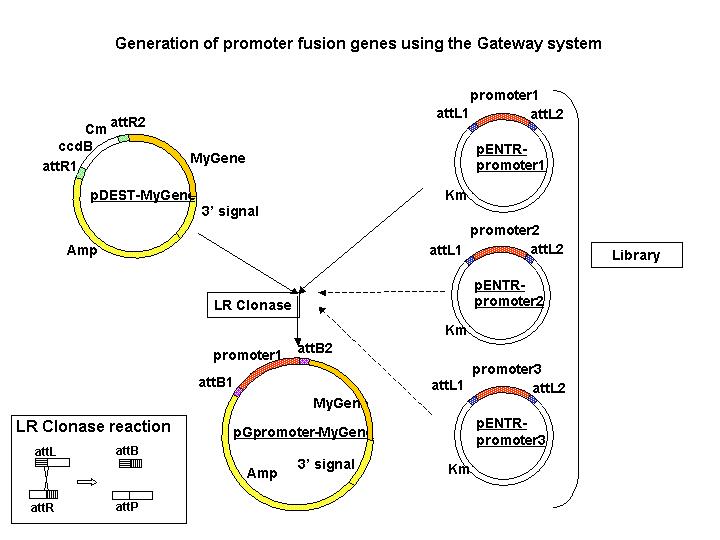
English / Japanese

Generation of pENTR-promoter plasmidsกกGeneration of pDEST-MyGene plasmids
A protocol for LR reaction (in preparation)
We employ Gateway system to facilitate generation of promoter fusions used
to express genes of interest in particular cells or tissues of C. elegans. The general procedure is as follows.
1) Promoters that are known to be expressed in specific cells are subcloned
into the pENTR vector to generate pENTR-promoter plasmids. Their expression
patterns are verified (*). The collection of pENTR-promoter plasmids serves
as a library for generation of various promoter fusions.
2) The gene of interest (called "MyGene" here) is subcloned into
the pDEST vector.
3) By a site-specific recombination between pENTR-promoter and pDEST-MyGene,
which is catalyzed by LR Clonase (Invitrogen), the promoter and MyGene
is joined exactly as designed to generate a pG-promoter-MyGene plasmid.
4) The pG-promoter-MyGene plasmid is introduced into C. elegans to see the effect of cell-cpecific expression of MyGene.
(*) We have generated reporter plasmids such as pDEST-GFP, pDEST-CYP, pDEST-YFP,
pDEST-Venus and pDEST-DsRed. A newly constructed pENTR-promoter plasmid
is usually joined with one of the reported genes first by recombination
with pDEST-reporter and the expression pattern is verified by introduction
into C. elegans.
The advantage of this system is that you do not have to use restriction
enzymes, which sometimes make plasmid constructions complicated. In the
Gateway system, once you make a pENTR-promoter plasmid, it can be easily
joined with any gene that are subcloned into the pDEST vector.
In many cases, the promoter fragment is amplified from the genome or a
cosmid by PCR. In these cases, it is desired that the expression pattern
be verified before further subcloning, because of potential mutations introduced
by PCR reactions. The advantage of Gateway system is especially important
in these cases.
(Important notice)
The "promoters" in our system do not include the initiation codon,
ATG. Therefore, "MyGene" should include its own initiation codon
(ATG), and resulting fusion genes will be trancriptional fusion rather
than translational fusion in a strict sense. This setup has a disadvantege
of being incompatible with the "ORFeome project"(Reboul et al.,
Nature Genetics 34: 35-41 2003). However, we decided to adopt this system
in order to avoid introduction of eight amino acids that come from the
attB recombination signal when MyGene does not carry its own initiation
codon. This is because our system is mainly aimed at cell-specific gene
expression experiments for studies of in vivo gene functions.
For plasmids that we have generated so far, see the following database.
C. elegans promoter/marker database
See Invitrogen home page for the principle and general descriptions of Gateway system.
